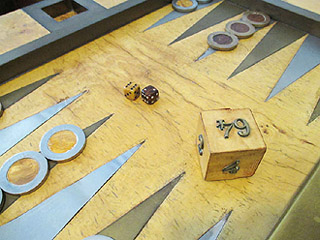|
| Magriel's NYT Columns |
 The Black and White San Francisco Classic Backgammon Tournament last weekend attracted a strong field that included all the top West Coast players. Allen van Gelder of San Francisco took top honors by defeating Michael Maxakuli, president of the Las Vegas Backgammon Club. Aram Kouleyan, last year’s winner, and Alan Martin were semifinalists. In other sections: George Matthews overcame Ted Kim to win the consolation; Lynn Madlener took the last chance, and Richard Maurer beat Mike Margolis in the intermediate.
The Black and White San Francisco Classic Backgammon Tournament last weekend attracted a strong field that included all the top West Coast players. Allen van Gelder of San Francisco took top honors by defeating Michael Maxakuli, president of the Las Vegas Backgammon Club. Aram Kouleyan, last year’s winner, and Alan Martin were semifinalists. In other sections: George Matthews overcame Ted Kim to win the consolation; Lynn Madlener took the last chance, and Richard Maurer beat Mike Margolis in the intermediate.
With the two finalists sequestered in a closed room, several hundred spectators were able to observe the 21-point finals on closed-circuit television. In the first half of this well-played match both players won some lucky games but neither was able to build up a lead. With the score tied 11–11, however, the luck of the dice shifted in favor of van Gelder. He won the next two games and went ahead 14–11. In the following decisive game, van Gelder (Black) obtained a slight advantage and gave Maxakuli (White) a somewhat premature double. Several rolls later, the diagrammed position was reached.
|
11
MATCH TO 21 14 |
| Black to play 3-1. |
Black’s first priority is the safety of his own two back men, which are split in White’s home board. The blot on the 21-point is dangerously exposed to White’s builders, which are poised to attack. Black cannot afford to give White the opportunity to seize the 21-point and so form a 5-in-a-row prime (from the 21-point through the 17-point). Accordingly, it is essential for Black to button up by playing 24/21 with his 3. By making the 21-point himself, Black settles the situation on White’s side of the board and can then turn his attention to containing White.
After playing the 3, 24/21, Black still must decide how to play the 1. The conservative choice is 7/6, stacking a fifth man on the 6-point. Although safe, this play is awkward and makes it difficult for Black to further develop his position. Instead, van Gelder decided on a more aggressive alternative.
The correct play is 24/21, 6/5, putting a single man on the 5-point. By slotting the 5-point, Black gambles that White will be unable to hit next trn with a 4 (14 chances out of 36 possible.) If White misses, then Black will be in a position to cover his blot and obtain a winning position.
Slotting here is the most forceful and direct way for Black to realize his advantage. Furthermore, even if White hits, all is not lost — because Black has established the 21-point, he will still have a lot of counterplay.
In the actual game van Gelder’s play succeeded: White failed to roll a 4, Black covered the 5-point, and Black was fortunate to win an unexpected gammon (double game). Maxakuli tried hard to make a comeback, but van Gelder’s 18–11 lead proved insurmountable.
Rollout
 Tom Keith 2013 |
|
Match to 21 White 11, Black 14 White owns 2-cube Black rolls 3-1 1296 games with VR Checker play: 2-ply Cube play: 3-ply Red |
| 3-1: | Game | G | BG | Equity | ||||
| 1 | 24/21, 6/5 |
W L |
.5893 .4107 |
.1807 .0897 |
.0107 .0034 | +0.0120 |

| |
| 2 | 24/21, 7/6 |
W L |
.5693 .4307 |
.1783 .0843 |
.0070 .0037 | −0.0383 | (0.0503) |

|
|

